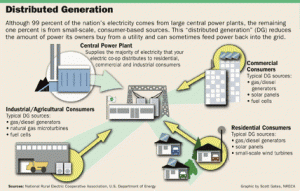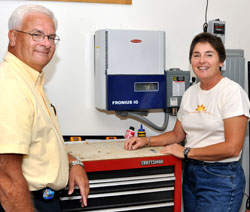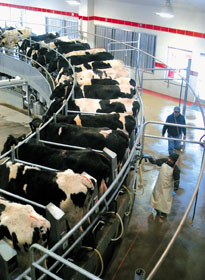
Floyds Knobs resident Revone Bauwens lives an Earth-friendly lifestyle, from the Prius she drives, to the nationally-certified wildlife habitat she’s created in her back yard to the two sets of solar panels on her roof. One set produces electricity, the other hot water. They are part of a growing movement of home-grown energy known as “distributed generation.”
Consumers find growing role in creating their own energy
The electric meter on Revone Bauwens’ house was spinning backward one sunny morning last month. But nothing was wrong with the meter. Nor was the Floyds Knobs resident doing anything shady.
Everything was on the up-and-up under the full light of day — atop the south-facing slope of Bauwens’ back roof.
There, 14 solar panels were collecting the sun’s energy and converting it to earth-friendly electricity. Like most sunny mornings since she installed the panels last year, the panels were generating more kilowatts than she was using at the time. Through an agreement with the folks at her electric utility, to trade her kilowatts for theirs, the little excess she generated was backed onto the distribution lines for others to use and to reduce her monthly bill.
 “These are the days solar panels work the best: when it’s a little chilly and it’s as sunny as all get out,” Bauwens said. “These are the days I’m making as much electricity as I can.”
“These are the days solar panels work the best: when it’s a little chilly and it’s as sunny as all get out,” Bauwens said. “These are the days I’m making as much electricity as I can.”
The 3-kilowatt solar-panel system provides about half the electricity the 49-year-old advocate for sustainable living and her 11-year-old son use over the course of a year in their super energy-efficient home. Recent electric bills varied between $30 and $4. That includes the monthly service charge.
“When I first put the system in, three times a day I had to run out and watch the meter run backwards,” she said.
“She’s a pioneer,” said Bob Geswein, the energy-efficiency expert at Harrison REMC which serves in the rural Floyds Knobs area. His job is to help consumers get the most for their energy dollar. But Bauwens has taken efficiency and added a whole other level: saving energy and producing it.
As energy costs continue climbing, more and more people are looking at ways to make their own. While Bauwens and Geswein both note there are still significant economic and lifestyle hurdles consumers should first consider when following her trail, on-site power production is seen as part of a long-term solution to meeting the nation’s future energy needs in an environmentally-friendlier way.
As discussed in previous issues of Electric Consumer, huge increases in demand for electricity, a shortage in capacity and concerns over global climate change are threatening the nation’s supply of electricity like never before.
 Distributed generation, as residential and commercial on-site power production is called, is the seventh and final piece of an ambitious array of strategies outlined last year by the Electric Power Research Institute, a non-profit, utility-sponsored organization whose members include electric co-ops. The EPRI plan outlines how U.S. electric utilities could reduce carbon dioxide emissions to 1990 levels by 2030, while still meeting the projected 40 percent boost in electricity demand.
Distributed generation, as residential and commercial on-site power production is called, is the seventh and final piece of an ambitious array of strategies outlined last year by the Electric Power Research Institute, a non-profit, utility-sponsored organization whose members include electric co-ops. The EPRI plan outlines how U.S. electric utilities could reduce carbon dioxide emissions to 1990 levels by 2030, while still meeting the projected 40 percent boost in electricity demand.
The seven parts of the plan, dubbed the “Prism Analysis” because of the colorful way its elements incrementally graph the total possible CO2 reductions, include: conservation and energy efficiency, renewables, nuclear power, clean coal, carbon capture and storage, plug-in hybrid electric vehicles, and distributed generation.
EPRI suggests distributed generation, if pursued aggressively, could meet as much as 5 percent of the nation’s baseload electric needs by 2030. That’s twice the total percentage of wind, solar, biomass and all other non-hydro sources of renewables used in the U.S. today.
Distributed generation like biomass also is expected to reduce the U.S. dependence on oil and natural gas imports.
A new day dawning
Distributed generation is not new. Before central-station electricity, all energy requirements — heating, cooling, lighting — were supplied at their point of use.
Technical advances, environmental issues and inexpensive fuel gradually gave rise to the “grid” — the giant interconnected network of large “economies of scale” power plants and transmission and distribution lines carrying low-cost, reliable power to every corner of the country.
But given today’s concerns over carbon dioxide and its link to global climate change, and public opposition to new large-scale plants and miles of transmission lines needed to carry their power, utilities and their consumers are all looking for new ways to produce and deliver the electricity that powers our modern lives.
For Revone Bauwens, the investment in solar was all about the environment and reducing the use of fossil fuels at her home. A native of southern California, she has been researching renewable energy for 20 years. Along with volunteering for a number of social-service organizations in the Louisville area, the former Navy pilot — who now flies 747s for UPS — devotes her energies to promoting alternative energy and sustainable lifestyles.
She does figure the payback for her 14 solar panels will come around the year 2030, factoring in estimated electric rate increases. She installed the panels, doing much of the work herself, for around $19,000 (after a $2,000 federal rebate).
Alongside the photovoltaic panels are four solar heat-collecting panels installed when she and her ex-husband built the home in 2004. These panels produce most of the home’s hot water. In winter, they also provide radiant heat to the home’s smooth concrete floors.
With the radiant heat, she estimates the payback for the solar heating system to be about five years, rather than seven or eight years if the hot water was used only for consumption. The solar heating system gives her an annual 6 percent cut in property taxes, too.
When the sun isn’t making enough heat for the radiant floor system to keep the house warm in winter, she fires up a wood stove located in the center of the home. Her stove is connected to a catalytic converter that essentially burns the smoke a second time. This gives off more heat and reduces the final emissions from the burning wood. Finally, she has a high-efficiency electric heat pump for the coldest winter days.
Both sets of solar panels are just the second part of a systemic sustainable trilogy — a three-legged stool — by which Bauwens lives her life. The first part, she said, is building a home that’s insulated and sealed tightly so it doesn’t waste energy. “The best thing you can do is build the house correctly. That’s where you’re going to get your money back,” she said. “Solar is not an effective use of money if a home is not working the way it’s supposed to work.”
Once the house is working and products like solar panels and energy efficient appliances are in place, the third part is what she calls “processes” — changing wasteful habits and living a more environmentally-aware lifestyle. For Bauwens, that includes everything from the way she cooks, uses water, landscapes and drives.
“Before you do anything,” she said, “you go through your house and you do analysis. You find out that you’re wasting energy, and you’re wasting hot water. So in the months before you put these panels up, you are compelled to cut your electricity use in your house.”
She said she whittled her electric use in the 3,400-square-foot home, which was built for a family of four, from about 1,200 kilowatt-hours a month down to 900. Now with the panels, she buys on average over a year only about 450 kwh a month from her utility.
 Bauwens’ advice echoes what Indiana’s electric co-op energy advisors say to consumers inquiring about adding solar or wind generation. “Work on reducing your energy appetite first,” Geswein at Harrison REMC instructs, “and we could solve a lot of energy problems.”
Bauwens’ advice echoes what Indiana’s electric co-op energy advisors say to consumers inquiring about adding solar or wind generation. “Work on reducing your energy appetite first,” Geswein at Harrison REMC instructs, “and we could solve a lot of energy problems.”
Redefining ‘cooperative’ power
Geswein has been delivering the message of building high-performance homes in seminars for Harrison REMC consumers and around the state for years. Now, with distributed generation becoming more mainstream, Indiana’s electric cooperatives are responding along those lines, too, and redefining “cooperative” power.
Hoosier Energy REC, power supply cooperative of the consumer-owned electric co-ops in the southern half of Indiana, began a pilot project in late spring to gather real-world data on distributed generation for consumers.
In June, across Turtle Creek Reservoir from its Merom Generating Station, one of the co-op’s two coal-fired power plants, the power supplier has added a residential-sized wind turbine and an array of solar panels to its environmental education center. Another wind turbine and solar array came on line in September at its Victory substation just north of Jasper.
“Many residential consumers are interested in the feasibility of renewable energy technology, but they need good information about equipment and operating costs to make decisions,” said Heath Norrick, Hoosier Energy’s manager of renewable energy.
As the data is gathered over the next year and a bigger picture emerges, Hoosier Energy and its cooperatives will have the kind of numbers for potential power production and payback consumers are wanting.
 “My phone has been ringing. The interest is definitely there,” said Brad Morton, owner of Morton Energy, “but the cost is still prohibitive for most people … unless your goal is to be environmentally friendly. That’s got to be part of the formula for a personal decision.”
“My phone has been ringing. The interest is definitely there,” said Brad Morton, owner of Morton Energy, “but the cost is still prohibitive for most people … unless your goal is to be environmentally friendly. That’s got to be part of the formula for a personal decision.”
The Evansville-based company, specializing in the relatively uncharted field of residential renewable energy products and services in Indiana, is working with Hoosier Energy on the project.
“People will come thinking this is going to be a money maker,” Morton added of renewables, “but it’s only going to offset your own use.”
Right now, the cost for adding either wind or solar is about $10,000 per kilowatt of installed capacity. At the Jasper substation, the 1.8 kw wind turbine and the 3 kw solar array price out at around $50,000.
Morton said Hoosiers can’t expect the same results they see on TV from folks in southern California with similar equipment because electric rates there are twice as high and the climate is more conducive. Payback estimates here can vary widely from 15 to 35 years, depending on the utility and how future rate increases and a multitude of other variables are factored in. But one thing is for sure: Electric rates are going to only continue climbing, especially as utilities add new baseload generation in this new carbon-constrained environment. As rates rise, the financial return on renewable sources comes sooner.
Working with utilities like Hoosier Energy, Morton said, is a win-win for all. He said distributed generation can help power companies mitigate the growing demand and the high cost of adding capacity. “It’ll be financially beneficial and environmentally beneficial,” he said.
 On the north end of the state, four large dairy farms that located in Newton and Jasper counties in the past decade are already reaping win-win benefits from their on-site power generation. The Herrema, Bos, Hidden View and Fair Oaks dairies have installed anaerobic digesters that take the abundant manure from their cows and breaks it down into methane gas and more benign solid and liquid byproducts. The methane gas is used to power generators at the dairies. The dairies use the electricity and the heat the generators create to reduce their energy needs.
On the north end of the state, four large dairy farms that located in Newton and Jasper counties in the past decade are already reaping win-win benefits from their on-site power generation. The Herrema, Bos, Hidden View and Fair Oaks dairies have installed anaerobic digesters that take the abundant manure from their cows and breaks it down into methane gas and more benign solid and liquid byproducts. The methane gas is used to power generators at the dairies. The dairies use the electricity and the heat the generators create to reduce their energy needs.
Through their electric co-op, Jasper County REMC, the dairies sell any excess they have to Wabash Valley Power Association, the power supply cooperative for REMCs in the northern half of Indiana.
“We try to be accommodating of generation in all types of different applications,” said Greg Wagoner, vice president of business development at Wabash Valley.
Wagoner noted that rapid changes are on the horizon in the way consumers interact with their electric utility. “Smart metering” technology he said will give consumers more control over their energy costs and energy-use decisions by giving them real-time pricing and incentives to use electricity more wisely and efficiently.
That technology and the rise of distributed generation — along with the projected energy shortages — also will change the way consumers are billed. Right now, the rates most consumers pay are structured in tiers that drop as their electric use increases. These tiers will be turned upside down in coming years as utilities nationwide do what utilities in places like California have already done. There, consumers who use less electricity are being rewarded with lower rates. The rates increase as use increases. Time-of-day pricing also comes into play to encourage less consumption at midday when electricity is in peak demand and short supply.
Those generating their own power probably can expect to see a more standardized treatment of any excess they sell to the grid in the near future, too. Instead of trading kilowatt for kilowatt, consumers generating electricity will probably receive only a lower wholesale rate for their power because residential rates include the costs for power line construction, maintenance and other fixed costs associated with electric distribution that on-site power producers don’t have.
A new way of life

An array of photovoltaic panels, left, capable of producing 3 kilowatts, and a 1.8 kilowatt wind turbine — both residential-sized applications — have been added to a Hoosier Energy REC substation north of Jasper. The renewable energy devices are part of a pilot project the Bloomington-based power supplier began earlier this year to gather real-world data. Residential consumers will be able to use the data to make informed choices about whether to install the distributed generation units themselves.
An array of photovoltaic panels, left, capable of producing 3 kilowatts, and a 1.8 kilowatt wind turbine — both residential-sized applications — have been added to a Hoosier Energy REC substation north of Jasper. The renewable energy devices are part of a pilot project the Bloomington-based power supplier began earlier this year to gather real-world data. Residential consumers will be able to use the data to make informed choices about whether to install the distributed generation units themselves. Photos by Richard G. BieverIn her home, Revone Bauwens has posted a series of photos as a lesson for her fifth-grade son, Curtis. First is a satellite photo of just their home in the Pebble Creek subdivision, then there’s one of the entire subdivision, then the state of Indiana, then the United States. Then she has photos of the Earth and solar system.
She tells him, “Your neighborhood is not Pebble Creek, it is the world. The pollution and trash we throw out affects the poor people on the other side of the world.”
She said he gets it. “My son knows we just don’t live in our house.” But while she gladly speaks about her home and lifestyle to many groups, from the Sierra Club to Girl Scouts, she knows it’s best to lead by example.
“You don’t preach. You don’t get pessimistic. You just do the right thing,” she said.
Following the creed, “think globally, act locally,” Bauwens is shedding early light on what will be the future — more power generated from our own back yards. “You just know we’ll find a way,” she said, “to have clean energy.”



